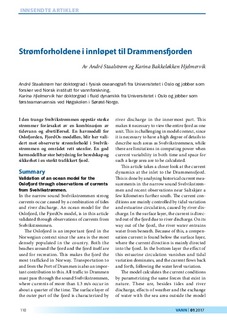Strømforholdene i innløpet til Drammensfjorden
Journal article, Peer reviewed
Published version
Permanent lenke
http://hdl.handle.net/11250/2563551Utgivelsesdato
2017Metadata
Vis full innførselSamlinger
- Publikasjoner fra Cristin - NIVA [2160]
- Scientific publications [1172]
Originalversjon
Vann. 2017, 52 (1), 104-115.Sammendrag
Oslofjorden er en viktig fjord i norsk sammenheng siden dette området er det tettest befolkede i landet. Både selve fjorden og strendene brukes som rekreasjonsområder, som bidrar til at fjorden er den mest trafikkerte i Norge. Transport til og fra Drammen havn er også et viktig bidrag til dette, hvor all trafikk må gå gjennom den trange og strømsterke Svelvikstrømmen, hvor strømstyrker over 1,3 m/s forekommer i omtrent en fjerdedel av tiden. Overflatelaget langt ut i fjorden er preget av elvetilførsel helt innerst i fjorden, noe som gjør det nødvendig å se på hele fjorden som en helhet. Dette er utfordrende i modellsammenheng, siden det da er nødvendig å ha en stor grad av detaljer for å beskrive for eksempel Svelvikstrømmen, mens det er begrensninger i regnekraft når strømvariasjon i både tid og rom for et så stort område skal beregnes. I denne artikkelen blir spesielt strømdynamikken ved innløpet til Drammensfjorden studert. Dette blir gjort ved å analysere historiske strømmålinger fra selve Svelvikstrømmen og nyere målinger fra Saltskjær noen kilometer lenger sør. Strømforholdene er hovedsakelig styrt av tidevannsvariasjon og estuarin sirkulasjon forårsaket av elvetilførsel. I overflaten er strømretningen i middel rettet ut av fjorden. På sin vei utover i fjorden river elvevannet med seg vann fra vannlagene under. Derfor befinner det seg under overflatelaget en kompenasjonsstrøm hvor strømretningen hovedsakelig er rettet innover i fjorden. I bunnlaget er ikke strømmen påvirket av den estuarine sirkulasjonen, og tidevannsvariasjonen dominerer, og det strømmer omtrent like mye innover som utover i takt med vannstandsvariasjonen. Modellen beregner strømforholdene ved å legge inn de samme drivkreftene som fins i virkeligheten. Dette er foruten tidevann og elvetilførsel, effekter fra vær og vind og utveksling av vann med havområdet på utsiden. Modellen lykkes i stor grad å gjenskape den observerte dynamikken. Dette gjør at FjordOsmodellen både kan beskrive dynamikken i de områdene av fjorden hvor det er trange sund og sterk strøm, og samtidig ser på fjorden fra Drammen og Oslo havn og helt ut til Færder som en helhet. // Validation of an ocean model for the Oslofjord through observations of currents from Svelvikstrømmen. In the narrow sound Svelvikstrømmen strong currents occur caused by a combination of tides and river discharge. An ocean model for the Oslofjord, the FjordOs model, is in this article validated through observations of currents from Svelvikstrømmen. The Oslofjord is an important fjord in the Norwegian context since the area is the most densely populated in the country. Both the beaches around the fjord and the fjord itself are used for recreation. This makes the fjord the most trafficked in Norway. Transportation to and from the Port of Drammen is also an important contribution to this. All traffic to Drammen must pass through the sound Svelvikstrømmen, where currents of more than 1.3 m/s occur in about a quarter of the time. The surface layer of the outer part of the fjord is characterized by river discharge in the innermost part. This makes it necessary to view the entire fjord as one unit. This is challenging in model context, since it is necessary to have a high degree of details to describe such areas as Svelvikstrømmen, while there are limitations in computing power when current variability in both time and space for such a large area are to be calculated. This article takes a closer look at the current dynamics at the inlet to the Drammensfjord. This is done by analysing historical current measurements in the narrow sound Svelvikstrømmen and recent observations near Saltskjær a few kilometres further south. The current conditions are mainly controlled by tidal variation and estuarine circulation, caused by river discharge. In the surface layer, the current is directed out of the fjord due to river discharge. On its way out of the fjord, the river water entrains water from beneath. Because of this, a compensation current is found below the surface layer, where the current direction is mainly directed into the fjord. In the bottom layer the effect of this estuarine circulation vanishes and tidal variation dominates, and the current flows back and forth, following the water level variation. The model calculates the current conditions by parametrizing the same forces that exist in nature. These are, besides tides and river discharge, effects of weather and the exchange of water with the sea area outside the model domain. The model succeeds in reproducing the observed dynamics. This means that the FjordOs-model both can describe the dynamics of the flow in the areas of the fjord where there are narrow straits and strong currents, and at the same time describe the fjord from Drammen and Oslo harbour and all the way out to the Færder, as one fjord system.
